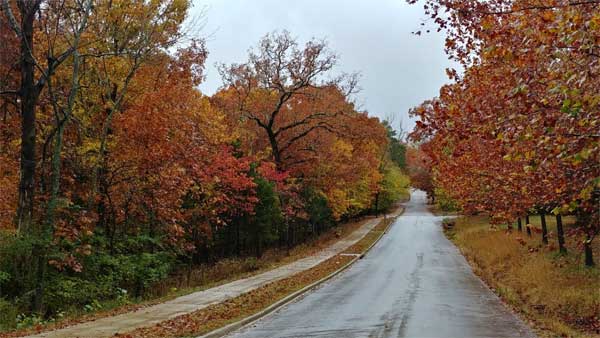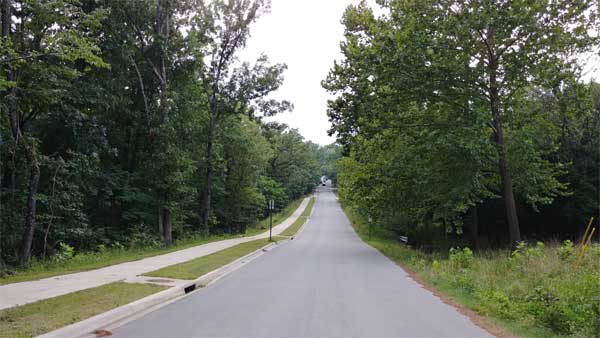Maggie’s Road
by Lisa Orton
|
Community Radio show aired on KPSQ 97.3 FM: |
Maggie was born Mary Magdalene Egle “of French Alsatian stock” in Winona, Wisconsin, August 13, 1862. Maggie and her husband, Cassius L. Pratt, moved to Washington County, Arkansas from Texas in the 1890s. They had four sons and two daughters, Joy (who later became Mrs. Joy Pratt Markham) and Evangeline (who later became Mrs. Evangeline Pratt Waterman Archer). In Texas, Mr. C. L. Pratt accumulated lands which were used for ranching and farming. He also served as county judge. In 1900, the Pratt family moved to Fayetteville, where they settled on what is now called Markham Hill, west of Fayetteville. Reasons given were Maggie’s health and the children’s education.
During my research on Joy and Evangeline’s mother, I found the following article on Maggie which displays the perseverance she must have passed down to her daughters. Evangeline displayed perseverance in her fight alongside Neil Compton and others to save the Buffalo River from being dammed in the 1960s to become the country’s first National River in the early 1970s. Likewise, Joy displayed perseverance after her divorce in 1931 in raising a three-year-old son while continuing her work to help boys and girls grow in healthy outdoor living and continuing her love for art, gardening, horses, and later philanthropy after she came into some money.
Fayetteville Daily Democrat, August 23, 1926
Woman Road-Builder Cuts
Drive to Town From 4 Miles to OneOrdinarily, road-building isn’t a woman’s job. It is, however, a big part of the plans of Mrs. C. L. Pratt of this place, who planned, in face of opposition, secured her right-of-way and then superintended personally the construction of the excellent road that now leads to her place on Pratt Heights, made famous recently under caption of “Camp Markham”. Several years ago, this special spot, while just a stone’s throw, as the crow flies, from the University, was a good several miles and 30 minutes drive from the depot, the college campus and the town. The reason was that there was no direct road to the Pratt home, only a round-about way that led over hills and dales and devious “bad spots” that most people like to avoid. Now the estate is but 10 minutes from town. Having for a home one of the Ozarks’ beauty spots, and having learned in her school days that a straight line is the shortest distance between two given points, Mrs. Pratt began looking around for a right-of-way from her own property to the road that connects with the University. She encountered difficulties. People whose farms were in the way didn’t want to give any ground. The town proper wasn’t interested. Not even her own family took the interest in the subject that she thought it deserved. So, she decided to become her own road-builder, and cut through to the University the best way she could.
Tired of Being Stuck in the Mud
“I made up my mind one rainy day in November, while I was sitting in my car which was sunk in the mud almost knee deep, waiting for someone to pull us out,” said Mrs. Pratt. “I decided right then that that was my last time to be stuck in the mud of bad roads, if I had to build a good one myself. The next day, I located a contractor, and by the middle of December, I had men, teams, and machinery all ready to start on the job. I planned to have the road ready for travel by Christmas. Little did I know then what a task it was to build a road. By Christmas, the road was hardly begun, and not until five months later, in May was it completed. If I had foreseen at the time, the enormity of the job I was undertaking, I never could have had the courage to begin.”
Her Own Superintendent
Two weeks later Mrs. Pratt let the contractor go, and from that day, she supervised the construction of every inch of the road herself. It was a slow job. Hundreds of trees had to be blasted up and their trunks removed. Much of the roadway had to be graded through literal beds of rock. Ditches had to be drained and bridges built. “The grader broke down almost every day,” explained Mrs. Pratt. “This was on account of the rocks we were going through. It was almost a daily trip for someone to ride to town for machinery to repair the grader.”
Works in Rain and Snow
All through the winter, day after day, Mrs. Pratt put on her “old black coat,” and stayed with her road-making from daylight to dark. Heavy snows fell; the spring rains set in; sometimes there was sleet or hail, and still she kept on, determined to finish her road. Some days, the workers could only go a few feet. There would be plenty of men, but no teams to drive, or again, several teams, with not enough drivers. Mrs. Pratt tells how she neglected her home and family completely for a while, the sooner to complete her road. In May, the road was finished. An excellent dirt road it was, leading over the hills, with fine views of the distant valleys. It led directly to the University, and, where the old road had been four miles long, this was only a little over one. “Every inch of its building was difficult,” declared Mrs. Pratt. “A thousand times, I wished that I had never started it, but I kept on because I hated to give up. I’m glad now that we have it. One of these days I shall put a coat of cinders over it, then indeed I’ll have a road to be proud of.” The county paid $200 on the road; a few neighbors gave some to it. Otherwise, Mrs. Pratt paid for as well as built the road.

Markham Road today, autumn

Markham Road today, summer